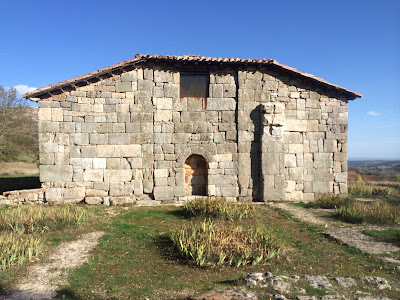There is something oddly fascinating about the shadowy Visigothic Kingdom that ruled Spain before the Muslim conquest. The Catholic Monarchs Ferdinand and Isabella were lauded in courtly song as the descendants of los Visigodos, and my maternal grandmother's family claimed a Visigothic bloodline of its own which may or may not be supported by facts. The only portrait I have ever seen of Grand Admiral Ruy Pérez (b. 642, fl. 680, one of about a million people in the family tree named Rodrigo or Ruy; family tradition insists there be at least one kicking around at all times) is an eighteenth-century engraving that fits him out with a rather unlikely full-bottomed wig and Bourbon court dress and turns the landscape around his humble watchtower at Villanañe into the gardens of Versailles.
Nonetheless, such is the mystery and power behind these lost lords of Spain that when I was traveling two years ago in northern Castille, we of course had to put in a stop at one of the last remaining relics of that era, the small hermitage chapel of Santa María de Lara. It was off the main road, and further off past the tiny village of Quintanilla de las Viñas, which I remember as little more than a knot of houses and for-sale signs amid rolling hills and high grass. The custodian, a fellow leaning on his motorbike, met us, though we only had about ten minutes as he had to get back to his girlfriend in town. The church stands on a little scrubby upland, beneath a much higher, more forbidding wall of bluffs. Its exact date is unknown, though it may be as old as the seventh century or as recent as the tenth, though the older date seems the most credible. A funeral stele now preserved at Burgos indicates it was rebuilt in the early 900s, after the settlement had been abandoned in the first flush of Moorish rule. A "Lady Flammola" was associated with a restoration around the same time, while the mother of Count Fernán González of Castile gave a donation to the church some decadeslater. It was later ceded to a local monastery, where, after serving as a hermitage, it fell into disuse. It was only rediscovered in the twentieth century, by a local priest, Don Bonifacio Zamora.
It was once cruciform, though all that is left of it is the transept and apse; from the exterior, it is humble, almost comically tumbledown, and its only remaining ornamentation are bands of grapes and vines in low relief. Within, very little remains. Imposts on the large horseshoe arch framing the apse--a Visigothic, not Moorish, feature here--depict allegorical figures of the sun and the moon, rather as in old paintings of the crucifixion.
There is little remaining figural art, though a small altar or plinth, now displayed to one side of the apse, shows what might be the earliest image of Christ in Spanish art, an odd, unsettling and almost unrecognizable bit of sculpture. Which brings me to why I felt this was worth sharing here at the New Liturgical Movement--something about the interior, about those cold and otherworldly and even troubling images, seemed completely other. Frightening, no; eerie, yes. The whole chapel, what is left of it, seems marked by an engaging otherness; as someone who often feels quite at home in the past, it was a sentiment I had seldom ever felt, even when confronted with cave paintings. I can't account for it--perhaps it is just the barbarian tastes of the Visigoths; it certainly wasn't their long-departed Arianism, as they had renounced that heresy at least a century earlier before the church was probably built. I do not know if it is religious awe, or an overactive imagination, or simply the distance of time, but it seems, like a place in a ghost story or a fairy tale, where anything, for good or ill, could happen.





